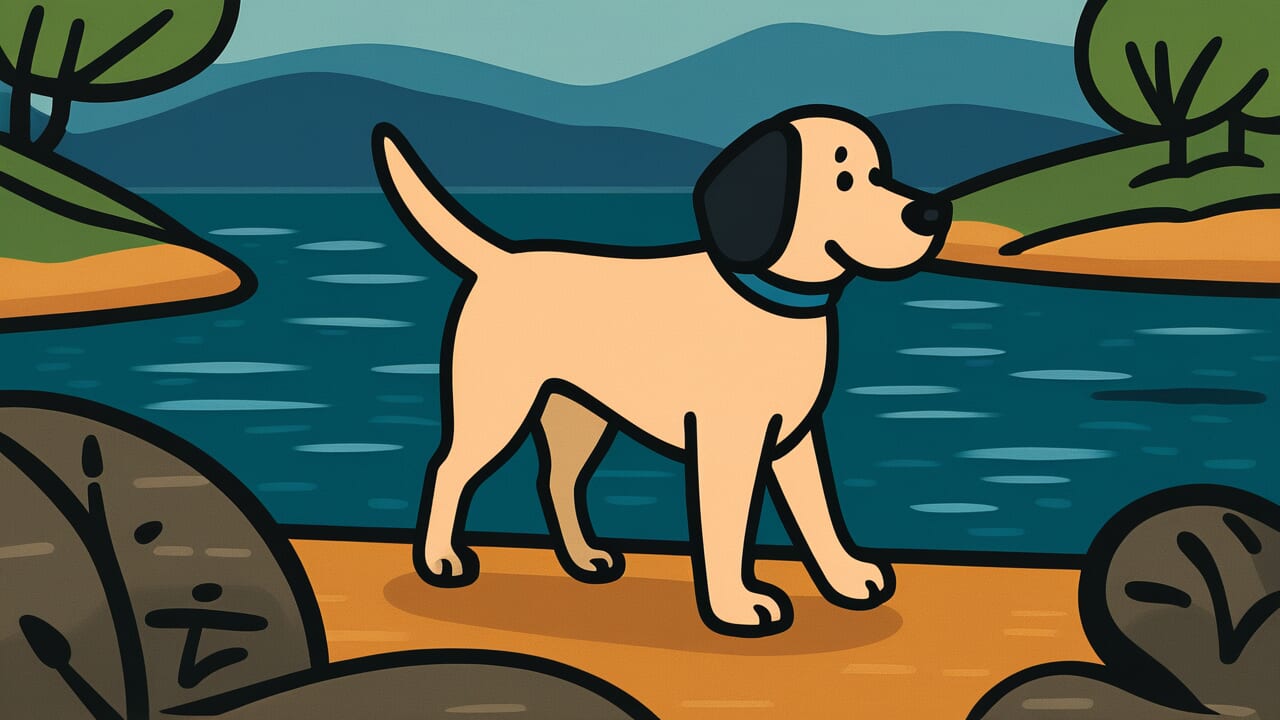How to Read “A dog walking along the riverbank”
Inu no kawabata aruki
Meaning of “A dog walking along the riverbank”
“A dog walking along the riverbank” is a proverb that describes someone wandering around restlessly without purpose, just like a dog walking along a riverbank.
It refers to people who move about nervously, going right then left, stopping suddenly then starting again, unable to settle down.
This proverb criticizes the state of appearing to search for something but actually finding nothing. It also describes wasting time because you can’t decide what to do.
People use it to tease restless behavior. For example, someone pacing around the office unable to focus on work.
Or a shopper wandering back and forth through a store, unable to decide what to buy.
Even today, this proverb works as an accurate metaphor. It describes lacking concentration and being unable to settle on one thing.
It also captures the state of moving around meaninglessly due to anxiety or impatience.
Origin and Etymology
No clear records exist showing when this proverb first appeared in literature. However, we can guess its origins by looking at the words themselves.
Let’s focus on the behavioral characteristics of dogs. When dogs go for walks, they repeatedly stop and start while sniffing various scents.
The riverbank is especially interesting to dogs because it’s a treasure trove of fascinating smells.
Waterside areas have traces of many creatures. There are spots where other animals drank water, fish smells, and water plant fragrances.
All these elements stimulate a dog’s curiosity.
Therefore, a dog walking along a riverbank doesn’t move in a straight line. It wanders right and left, puts its nose to the ground and stops.
Then it moves forward a bit and sniffs another spot. This behavior probably reminded people of humans wandering aimlessly without purpose.
During the Edo period, dogs were familiar companions to common people. Their behavior was observed daily.
People knew dog behavior patterns well. They used these patterns as metaphors to express human behavior.
Japan has many proverbs that compare animal habits to human actions. This is one of them.
Usage Examples
- Before the meeting, I got nervous and paced the hallway like a dog walking along the riverbank
- He’s been like a dog walking along the riverbank, unable to decide, but he should make up his mind soon
Universal Wisdom
The proverb “A dog walking along the riverbank” captures a universal truth about human mental instability.
Why do people wander around restlessly? It happens when the mind lacks clear purpose or direction.
Or when driven by anxiety or impatience, the body reflects that inner confusion.
What’s interesting is that people repeat this behavior even though they know it solves nothing.
When they should sit still and think, they stand up and walk around. Moving makes them feel like they’re doing something.
But in reality, that movement is just aimless wandering.
This phenomenon could be called a primitive human response to dealing with anxiety. Animals move around when they sense danger.
Humans also try to gain temporary comfort by moving their bodies when they feel psychological anxiety.
But that’s only a superficial coping mechanism. It doesn’t solve the fundamental problem.
Our ancestors expressed this human trait by comparing it to dog behavior. This wasn’t mere criticism.
The expression was born from deep understanding of a mental state anyone can fall into.
Restlessness is a human weakness when facing decisions. But it’s also proof of seeking something.
This proverb contains a warm gaze toward humanity.
When AI Hears This
A dog walking along a riverbank is actually biologically very rational behavior.
The boundary between river and land is a special area called an “ecotone” in ecology.
This boundary region attracts both waterside and land creatures. Studies show biodiversity per unit area is 20 to 50 percent higher than surrounding areas.
For dogs, the riverbank is an “information-dense zone.” It has drinking water, potential prey like fish and waterfowl, and small land animals passing through.
Walking one path lets them monitor two environments simultaneously. It’s an energy-efficient behavioral strategy.
Interestingly, this boundary-selection behavior unconsciously repeats in human society too.
For example, stores located between shopping districts and residential areas have higher sales. New businesses often emerge at boundaries between different specialized fields.
This follows the same principle. Where two domains meet, information and resources exchange more frequently.
The “boundary-walking strategy” that dogs instinctively execute is actually a mathematically optimal behavior pattern that maximizes survival probability.
Humans gathering at boundary regions seeking profit might also be a program evolution carved into our brains.
Lessons for Today
This proverb teaches modern people the importance of having courage to pause before acting.
In our busy modern society, we feel anxious unless we’re constantly doing something. But purposeless action is the same as doing nothing.
When you’re confused about something or feeling rushed, first ask yourself this question. “What am I really seeking right now?”
Until you find that answer, you don’t need to force yourself to move. It’s not too late to start moving after thinking carefully and determining your direction.
Especially in today’s digital age, we tend to do the riverbank walk in the sea of information.
We open and close social media, browse news sites, and keep touching our phones without searching for anything specific.
This is also a modern version of walking along the riverbank.
What matters is noticing your own restlessness. Then stop once, take a deep breath, and take time to determine what you really need.
If you do that, each of your steps will surely move closer to your destination.



Comments